
Presidential Airport Lounge, Bratislava, Slovakia. Photo: Lívia Pemčáková.
Kunstgewerbemuseum, Berlin
25 March – 16 July 2023
by SABINE SCHERECK
For more than 40 years the world was dominated by two alliances: the countries of the democratic west and those of the socialist east, divided by the so-called iron curtain. This division was reinforced by socialist governments, which did not want information from the west to infiltrate their states. At the same time, these governments made it difficult for outsiders to access information about their countries.
When in 1989 the Berlin Wall fell, reuniting the divided city, the alliance in the east slowly dissolved. However, the division was so deeply lodged in people’s minds that it has taken more than 30 years for those in the west, in this case the former West Berlin, to direct their view beyond East Germany and generate an interest in what happened behind the iron curtain – and see it from a historical perspective.
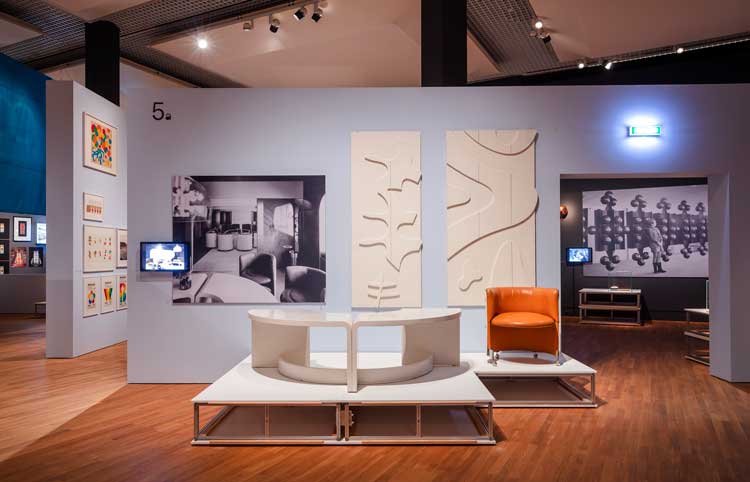
Retrotopia. Design for Socialist Spaces, installation view, Slovakia Section, Kunstgewerbemuseum + Kulturforum 2023. © Staatliche Museen zu Berlin / David von Becker.
Retrotopia: Design for Socialist Spaces, now at the Kunstgewerbemuseum, Berlin’s museum of decorative arts, is an ambitious exhibition encompassing 40 years of socialist design as it played out in 11 countries from the Baltic Sea to the Adriatic Sea, in public and in private spaces. The exhibition consists of two parts: the main part, which is housed in a large hall at the nearby Kulturforum, and the smaller part at the Kunstgewerbemuseum, which the lead curator, Claudia Banz, refers to as the “brain” behind the socialist design – the schools, the institutions, the networks, including international fairs and congresses, and the discourse – the philosophy on which the design is based.
When countries had to be rebuilt after the second world war, the aim was to create a better life for everybody, and design was to shape the future, a utopia. Retrotopia, the title of this exhibition, derives from the combination of the words “retrospective” and “utopia” on which it is looking back. What this future was meant to look like and what happened when it clashed with the reality of life under socialist regimes, which was marked by a shortage of materials and the oppression of personal freedom, is gathered here in the form of stained glass, chairs, cupboards, crockery, lamps, posters and other objects of everyday life.
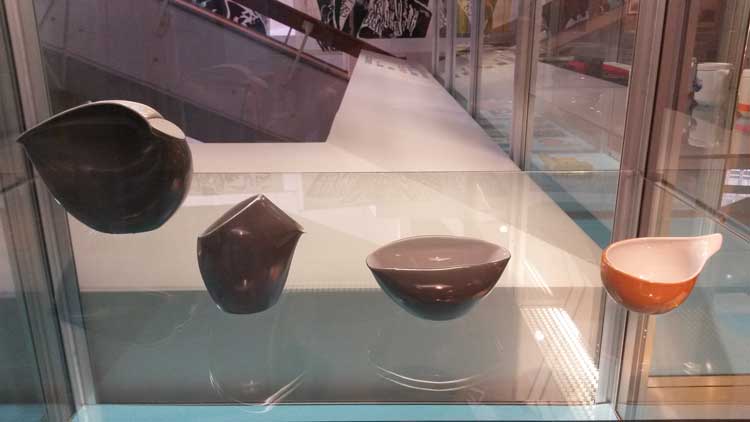
Pieces from the coffee sets Dorota and Ina, designed by Lubomir Tomaszewksi, Poland 1962, Kunstgewerbemuseum + Kulturforum 2023. Photo: © Sabine Schereck.
Other displays show brochures from schools, posters advertising exhibitions of yesteryear, cups and jugs. The simple but pleasing design of two porcelain coffee sets, named Dorota and Ina, can be traced back to the Bauhaus aesthetics. Yet, made in Poland in 1962, the shapes of the items have a certain twist. The larger jug and the little milk jug from the Dorota set and the cups from the Ina set originate from a period in Poland when designers had more artistic freedom than had been the case under socialist realism. Lubomir Tomaszewski, the Polish painter and sculptor who designed these pieces, was taking a risk because they did not conform to a traditional design and might not have found any buyers. In the event, the coffee sets became a great success.
While these objects can be understood to a certain degree without language, when it comes to documents with written information, the legacy of the former division between east and west becomes evident: there are those who can read what the brochures say in Czech, Polish, Hungarian or Russian, for instance, and those who can’t. For those with a western upbringing, this exhibition explores unknown territory, while for those who grew up in the former communist bloc, the show may be a trip down memory lane as they encounter familiar objects.
A pioneering achievement of this comprehensive exhibition is to bring objects from so many eastern European countries together. Unlike trade fairs of years gone by, in which products would showcase each country’s masterpieces, the selection here draws on objects of cultural and historic significance. This selection is presented at the Kulturforum, where artefacts from private and public spaces are placed alongside each other. The room is divided into 11 sections, each curated by a representative of the respective country, including Ukraine, Lithuania, Estonia, East Germany, Poland, Czechoslovakia, Hungary, Poland and the countries of the former Yugoslavia.
While navigating through the “brain” part of the exhibition was not simple, here a route is given. Yet, with no titles to the sections or labels for the displays, it is easy for the visitor to feel equally lost here. The only guidance are numbers on the walls. To understand the context of what you are looking at, you need to read up on the items in a brochure. Thus, at the well-attended opening weekend, many people were just staring at their brochures, trying to figure out what was being presented to them. Neither is there any audio guide that would allow the visitor to delve into what is shown and discover the insightful stories behind these seemingly unremarkable objects without the need to leaf through a distracting booklet.
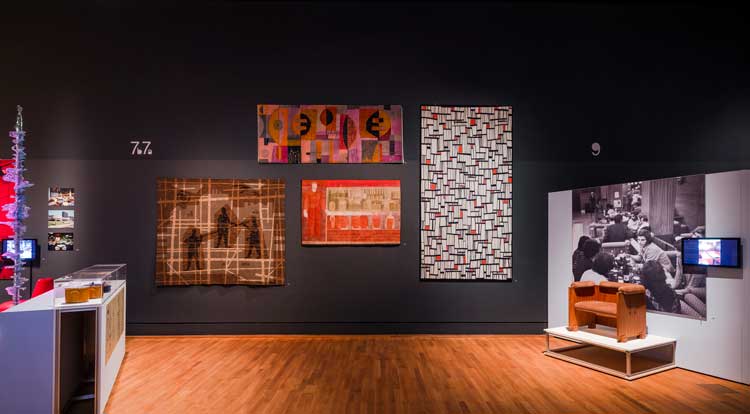
Retrotopia. Design for Socialist Spaces, installation view, Hungary Section, Kunstgewerbemuseum + Kulturforum 2023. © Staatliche Museen zu Berlin / David von Becker.
For instance, one wall shows a wall covering, tapestry and a curtain; a TV screen shows slide after slide of different partitions in restaurants, hotels and private houses. These were made in Hungary in the aftermath of the 1956 uprising: when the revolution was crushed, people were no longer allowed to organise themselves on a community level and retreated to their private spaces. This led to them putting up walls and building fences around their private realities.
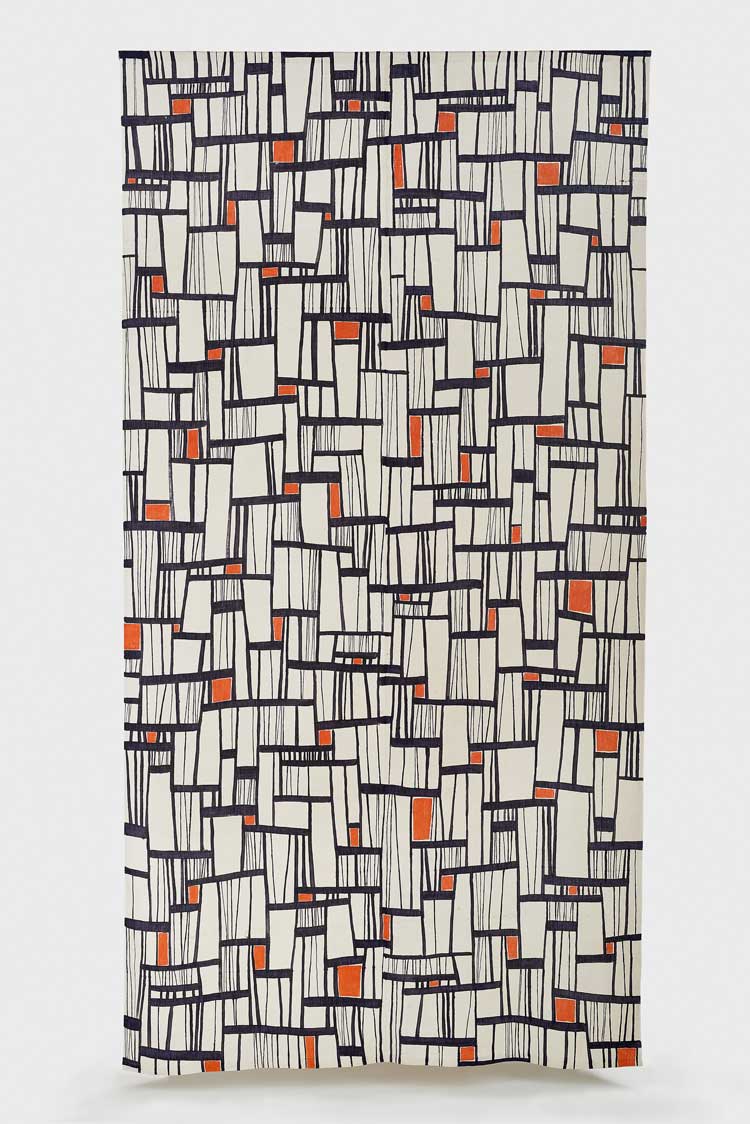
Irén Bódy, curtain, printed canvas, Hungary, 1959 © Museum of Applied Arts, Budapest.
In 1960s Hungary, the curtain became emblematic of this and spatial partitions were increasingly used in private and public spaces. In this section, co-curated by Judit Horváth, Melinda Farkasdy and Rita Komporday, the motives on the displayed wall decorations do not show views of a sky or a wide-open landscape, but, as in the case of Gizella Solti’s tapestry from 1960, workers building a wall; Irén Brody’s curtain is covered with abstract patterns reminiscent of grids. During the Prague spring in 1968, these structures became looser and brighter colours were adopted.
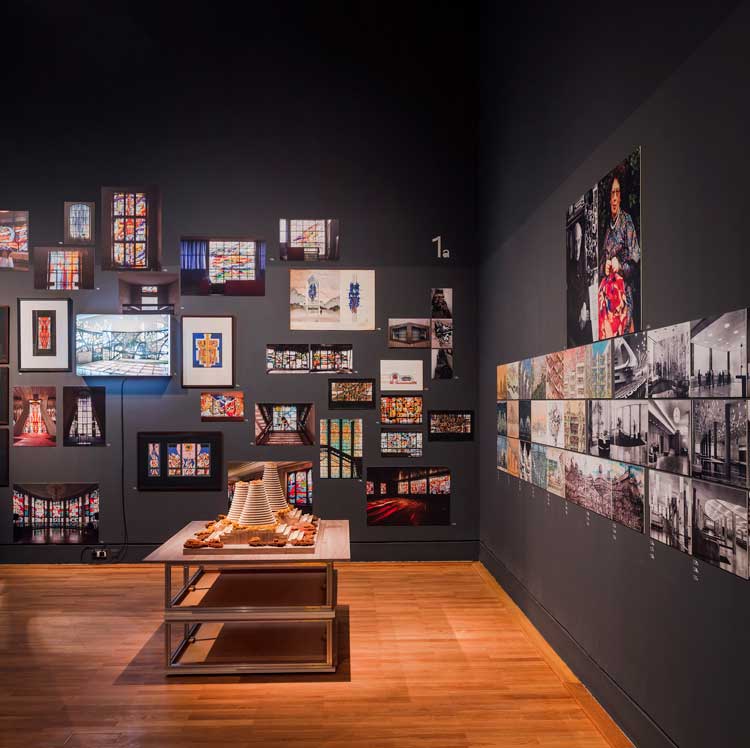
Retrotopia. Design for Socialist Spaces, installation view, Ukraine Section, Kunstgewerbemuseum + Kulturforum 2023. © Staatliche Museen zu Berlin / David von Becker.
In contrast to this, glowing colours are prominent in the Ukraine section. They feature in the 23 photos of, and designs for, stained-glass windows. They belong to a variety of buildings, ranging from the Hotel Olimpiia in Kamjanske in 1976, where the artist is unknown, via the Hungarian embassy in Kyiv with its stained-glass window created by Mykola Schkaraputo in 1978, to Iryna Hrechka’s stained-glass window for the Museum for Regional History in Ternopil in 1983. With these works, the curator Polina Baitsym wants to highlight the striving for artistic freedom outside the doctrine of social realism as well as fragility, transparency and hope.
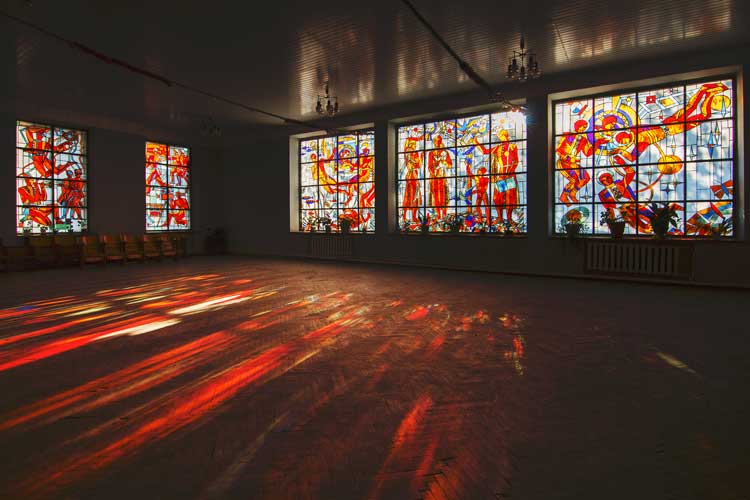
Stained-glass windows at Yuventus Students’ Club Ivan Ilko, handcrafted by Volodymyr Kuznietsov. Uzhhorod, Ukrainian Soviet Socialist Republic, 1984, Photo: Yevgen Nikiforov.
The idea of Retrotopia is well captured in the interior of the government lounge at Bratislava airport from 1974, designed by Vojtech Vilhan in collaboration with Ján Bahna. The minimalist round shapes of the table and chairs give the lounge a futuristic feel. From today’s perspective, it clearly reflects the 1970s zeitgeist, including the space age prompted by the space race between the US and the Soviet Union in the mid-1950s to mid-70s.
Public and private spaces are a rich source for design. Housing, living spaces and objects of everyday life, as well as major events such as the 10th World Festival of Youth and Students that took place in East Berlin in 1973, or the Mediterranean Games in Zagreb, in 1979, are areas curators drew from when putting together their part of Retrotopia. It is clearly hard to select just a few representative works from 40 years of design. The result is eclectic and feels at times random and overwhelming, which is not helped by the lack of guiding headlines. This leaves the visitor dissatisfied with a show, that, at its core, is informative and generates a wide interest. With its international approach, it would lend itself to being shown abroad, but there are no such plans.
The trend of major venues within Berlin’s exhibition landscape to open up to eastern Europe was ushered in by Magyar Modern: Hungarian Art in Berlin 1910-1933 at the Berlinische Galerie last autumn. This October, the Bröhan Museum will explore Czech art with Hej rup! The Czech Avant Garde in the Context of European Modernism. This chimes with the spirit of change as “Hej rup” translates as “Workers, Let’s Go”.